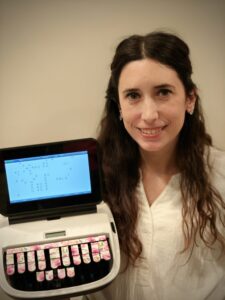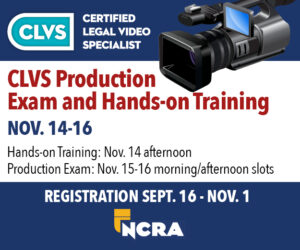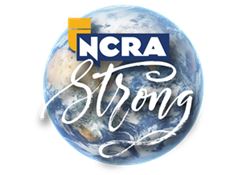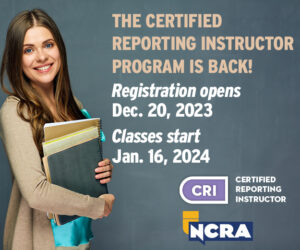By Linda Bland
It isn’t unusual for me to receive a call from a court reporter asking how to upgrade his or her writing to offer realtime writing as a service or how to transition to captioning or CART providing. However, I was very pleased when I received a call from Ms. Tessa Lewin of the U.S. Embassy, asking me if I would be interested in discussing how the Court Reporting at Home Realtime Writing Professional Development Program might train 44 official reporters for the Supreme Court of Jamaica. I immediately responded, “Yes! Absolutely! I would love to develop just this kind of project.” Having previously trained realtime writing court reporters in Zambia and Sierra Leone, Africa, my mind began immediately thinking how this might be accomplished.
Justice Bryan Sykes and his committee had determined that their reporters could benefit from upgrading their skills for realtime writing and speed, as well as other areas. Just the idea of the project was exciting. A great deal of thought and planning had already been developed by Justice Sykes and his committee, comprised of reporters, justices, IT department personnel, etc. By the time I was contacted, the committee had already had established a series of goals. When we met via video conferencing, I made a few more recommendations.
The Chief Justice of the Jamaican Supreme Court was so committed to the project, she allotted time during the workday for all reporters to be able to practice. How generous was that? Each morning, one group of reporters/students would be allowed to practice while other reporters covered court, and each afternoon they reversed roles. Being paid to train — who could refuse that offer?
A few months later, we entered into an agreement, and on Jan. 5, 2015, the project began. I had agreed to seven goals:
- Assess the reporters’ current speed writing level
- Assess the reporters’ realtime writing proficiency
- Train the reporters in Eclipse Audio Synchronization
- Make necessary steno dictionary conversions, build dictionaries, and make modifications
- Train two official supreme court reporters as trainers in all aspects of training, with emphasis on developing speed tests (writing the tests, counting in word and syllabic count, dictating the tests and proctoring speed tests)
- Implementing speedbuilding via the CRAH student platform
- Train two official supreme court reporters/trainers to update academics and customize them for Jamaican legal terminology, including study materials and tests.
I have learned during my many years of training reporters, captioners, and CART providers that all projects have challenges, and this one was no different. It would never have gotten off the ground without the dedication of Ms. Tanya Chung-Daley and Ms. Deline Cunningham, RPR, the court reporters designated as the two individuals who would be trained to be trainers of all future reporters for the court.
Our almost daily meetings, which later evolved into weekly meetings over the Internet, became an exciting, enjoyable part of my day. These ladies, fortunately, are so talented, it mde training them tremendously easier. In addition to handling their daily duties covering court, they had to go home to develop and dictate tests, or modify academics for the Jamaican judiciary, and countless other assignments I heaped upon them. They were working extended hours daily and weekends for months and months. And when I asked for materials back by Friday, I received them on Tuesday or Wednesday instead. My job was to stay ahead of them, to ensure that the next step in the training process was already prepared to prevent anyone from having to wait on any component of the project.
Our first two goals were to determine the reporters’ current speed and accuracy in translation. Imagine how difficult it is to schedule tests for this many reporters who have daily, ongoing court assignments including transcripts. Many of these reporters did not work in the Supreme Court in Kingston, Jamaica, but rather were in the circuit courts in cities all around the country.
Any court administrator knows the difficulty in simply keeping all courts covered. However, covering all the courts and scheduling the reporters for testing purposes was quite a feat. We had to test on three different dates, utilizing three different tests for speed at three different speed levels, as well as for realtime. The tests were graded utilizing NCRA grading guidelines, “What Is an Error?” as well as with a view toward the number of large and small drops the reporters were experiencing, how many of the errors were written correctly in steno but not contained in their dictionary, punctuation, and so on.
We then had a basis from which to work. We knew the speed levels we needed to address and the degree of the reporters’ translation accuracy. Knowing that the reporters and justices would benefit from audio synchronization, our first step was to introduce that feature. However, just as with all of us, some of us know our CAT software better than others, and it appeared some of the reporters required a review of some of the basic Eclipse features before we could introduce audiosync. Therefore, although basic training on the software was not a component of our agreement, I knew it was imperative, so I decided to employ someone who could refresh and walk the reporters through the basics.
Who could train my Jamaican reporters/students? I contacted an old acquaintance who put me in touch with Dineen Squillante, who is a certified Eclipse trainer. After one conversation with Dineen, I knew she was perfect for this project. Dineen developed a checklist for what we felt every reporter needed to know for basic realtime setup and editing, steno dictionary preparation, and so on. Each reporter was asked to fill out the checklist, designating which areas they felt needed additional training. Upon receipt of that information, Dineen developed multiple webinars that she presented to the trainers and that were recorded and provided for the trainers’ use in training the remaining reporters.
After the trainers determined that all the reporters were proficient in the basic features, we turned to dictionary building, conversion, and modifications, working on numbers, punctuation, etc. Dineen said, “Working on this project was one of the most enjoyable assignments of my entire career.”
Developing a literary, jury charge, or testimony test involves a great deal more than one can imagine unless you have served on a committee for the NCRA. Thankfully, we have counting software now that counts by word count as well as syllabic count. However, these software programs are not always 100 percent accurate and often require “tweaking.” Because of that, I felt it was important to teach the trainers how to compose a test, count the words in both word count and syllabic count, and dictate it. There is truly an art to dictating correctly and accurately. It can be the difference between being able to pass a test or fail one. It takes a great deal of practice for most instructors, but fortunately, once again, the trainers adapted to dictation quite easily.
Tanya and Deline, as well as the wonderful IT staffer, Duane Carr, teased me often about learning to “speak Jamaican.” When I would think the test “did not make sense,” I would be educated on certain phrases and how “it is spoken in Jamaican.” And without Duane’s IT expertise, we would never have completed this project.
We placed dictation developed by Tanya and Deline on my company’s student platform for the Jamaican reporters to practice, in addition to providing them access to hundreds of hours of our dictation if they chose to practice that as well. Tanya and Deline reviewed and edited our academics to determine what modifications were required for Jamaican law. We modified those and placed those on the platform as well, allowing their tests to be automatically and immediately graded, designating the errors they made and what the correct answer should have been.
And finally, I wanted the trainers to know how to edit or scope realtime. I called upon Dineen once again to train my trainers in realtime editing. If you haven’t tried realtime editing with your scopist, you have to do this. It saves a tremendous amount of time, and it is so easy. Do not be afraid to learn a new feature of your CAT software.
An awards ceremony was held for the reporters after they learned the realtime theory and writing concepts, and Deline and Tanya demonstrated realtime editing/scoping for all those present. While one wrote, the other edited the transcript simultaneously. If you aren’t familiar with realtime editing/scoping, your scopist may be in a different room, a different city, or even a different state, editing while you are writing the assignment.
In February 2016, my work ended. The materials for the Jamaican Project had been provided for realtime writing theory, speed building, and academics. The trainers and reporters had been trained in basic Eclipse, audiosynch, and realtime scoping. However, as we know, the road to building sufficient speed and accuracy and developing one’s steno dictionary are ongoing projects, and I knew Deline and Tanya to be quite capable of handling anything required by the Jamaican Supreme Court.
Deline stated, “The experience as trainers was a challenging and demanding one; however, with encouragement and assistance from Court Reporting and Captioning at Home, we were able to triumph over all the hurdles.” Tanya added, “Yes, and we are truly grateful for this experience.”
So, “Mon,” I didn’t get a trip to Jamaica, but I made a lot of wonderful Jamaican friends along the way, and we spread realtime writing to yet another part of the world. I am so grateful Court Reporting and Captioning at Home was chosen for this project and grateful also for all the assistance through the State Department, U.S. Embassy, the Jamaican Supreme Court, their IT Department, and of course, all 44 of the Jamaican Official Court Reporters.
My advice to you: Don’t stagnate! Realtime is attainable for anyone who is willing to put forth the effort. Don’t think that you can’t change your style of writing or that you are “too old.” You don’t have to change your entire theory at all. However, in all likelihood, you probably need to add a few realtime writing concepts to your theory. Remember, we all modify our theory somewhat, don’t we? We think of new briefs, or find another way to write our numbers, or a new way to write a “family” of words or contractions. We find new groups of phrases that work well for us.
If you want it, realtime is there for you to master – even from the comfort of your home. It requires taking one realtime concept at a time and mastering it to prevent you from causing hesitation in your writing. Writing realtime well isn’t accomplished in a one-day seminar, or even a week or a month. It can take anywhere from 90 days to a year or longer, depending upon how much work you need to employ to update your theory, how much time you make to practice, and how disciplined you are to completing your training. Every realtime writing concept you incorporate into your writing improves the translation, reduces the amount of time it takes to edit a transcript, and provides you more time to practice. It’s a win-win situation. However, you must take the first step to begin your journey.
Linda Bland, RMR, CPE, is the owner of Court Reporting and Captioning at Home, SSD Enterprises, LLC, Fla. She can be reached at LindaB@courtreportingathome.com.




















